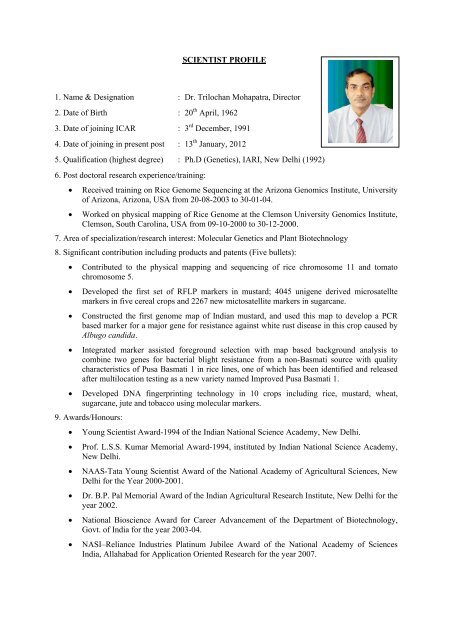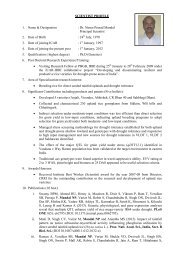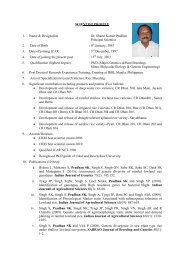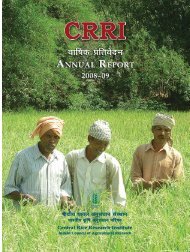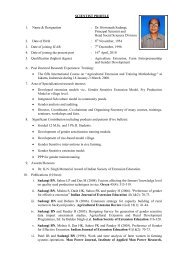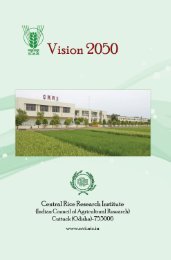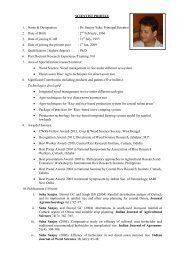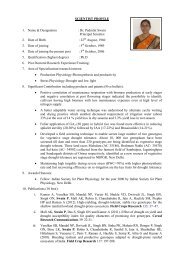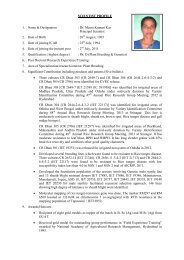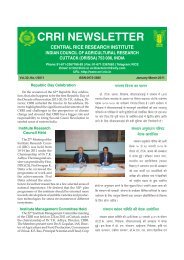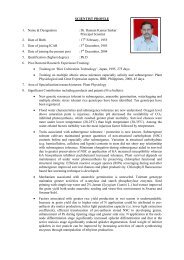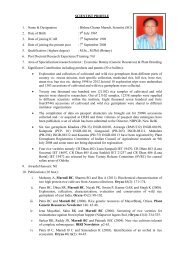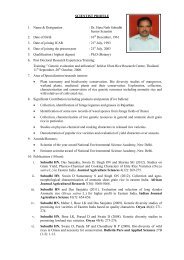Dr. Trilochan Mohapatra, Director - Central Rice Research Institute
Dr. Trilochan Mohapatra, Director - Central Rice Research Institute
Dr. Trilochan Mohapatra, Director - Central Rice Research Institute
Create successful ePaper yourself
Turn your PDF publications into a flip-book with our unique Google optimized e-Paper software.
SCIENTIST PROFILE<br />
1. Name & Designation : <strong>Dr</strong>. <strong>Trilochan</strong> <strong>Mohapatra</strong>, <strong>Director</strong><br />
2. Date of Birth : 20 th April, 1962<br />
3. Date of joining ICAR : 3 rd December, 1991<br />
4. Date of joining in present post : 13 th January, 2012<br />
5. Qualification (highest degree) : Ph.D (Genetics), IARI, New Delhi (1992)<br />
6. Post doctoral research experience/training:<br />
• Received training on <strong>Rice</strong> Genome Sequencing at the Arizona Genomics <strong>Institute</strong>, University<br />
of Arizona, Arizona, USA from 20-08-2003 to 30-01-04.<br />
• Worked on physical mapping of <strong>Rice</strong> Genome at the Clemson University Genomics <strong>Institute</strong>,<br />
Clemson, South Carolina, USA from 09-10-2000 to 30-12-2000.<br />
7. Area of specialization/research interest: Molecular Genetics and Plant Biotechnology<br />
8. Significant contribution including products and patents (Five bullets):<br />
• Contributed to the physical mapping and sequencing of rice chromosome 11 and tomato<br />
chromosome 5.<br />
• Developed the first set of RFLP markers in mustard; 4045 unigene derived microsatellte<br />
markers in five cereal crops and 2267 new mictosatellite markers in sugarcane.<br />
• Constructed the first genome map of Indian mustard, and used this map to develop a PCR<br />
based marker for a major gene for resistance against white rust disease in this crop caused by<br />
Albugo candida.<br />
• Integrated marker assisted foreground selection with map based background analysis to<br />
combine two genes for bacterial blight resistance from a non-Basmati source with quality<br />
characteristics of Pusa Basmati 1 in rice lines, one of which has been identified and released<br />
after multilocation testing as a new variety named Improved Pusa Basmati 1.<br />
• Developed DNA fingerprinting technology in 10 crops including rice, mustard, wheat,<br />
sugarcane, jute and tobacco using molecular markers.<br />
9. Awards/Honours:<br />
• Young Scientist Award-1994 of the Indian National Science Academy, New Delhi.<br />
• Prof. L.S.S. Kumar Memorial Award-1994, instituted by Indian National Science Academy,<br />
New Delhi.<br />
• NAAS-Tata Young Scientist Award of the National Academy of Agricultural Sciences, New<br />
Delhi for the Year 2000-2001.<br />
• <strong>Dr</strong>. B.P. Pal Memorial Award of the Indian Agricultural <strong>Research</strong> <strong>Institute</strong>, New Delhi for the<br />
year 2002.<br />
• National Bioscience Award for Career Advancement of the Department of Biotechnology,<br />
Govt. of India for the year 2003-04.<br />
• NASI–Reliance Industries Platinum Jubilee Award of the National Academy of Sciences<br />
India, Allahabad for Application Oriented <strong>Research</strong> for the year 2007.
• Special Recognition Award carrying a cash prize and citation by the Indian Council of<br />
Agricultural <strong>Research</strong> in the year 2009 for significant contribution to genetic improvement of<br />
Basmati rice.<br />
• Member, Editorial Board, Journal of Plant Biochemistry and Biotechnology from 2002-2008.<br />
• Associate Editor, BMC Genetics from 2011.<br />
• Associated Editor, Journal of Genetics, being published by the Indian Academy of Science,<br />
Bangalore from 2012.<br />
• Elected Fellow of the National Academy of Sciences India, Allahabad in the year 2005.<br />
• Elected Fellow of the National Academy of Agricultural Sciences, New Delhi in the year<br />
2006.<br />
• Elected Fellow of the National Academy of Agricultural Sciences, New Delhi from 2013.<br />
10. Publications (10 best):<br />
i. The Tomato Genome Consortium (2012). The tomato genome sequence provides insights into<br />
fleshy fruit evolution. Nature 485: 635-641. (T. <strong>Mohapatra</strong> worked as Co-PI of the Indian<br />
Initiative at the NRCPB, IARI, New Delhi).<br />
ii. Parida SK, Mukerji K, Singh AK, Singh NK and <strong>Mohapatra</strong> T (2012). SNPs in stressresponsive<br />
rice genes: validation, genotyping, functional relevance and population structure.<br />
BMC Genomics 13: 426.<br />
iii. Ngangkham U, Parida SK, De S, Raj Kumar KA, Singh AK, Singh NK and <strong>Mohapatra</strong> T<br />
(2010). Genic markers for wild abortive (WA) cytoplasm based male sterility and its fertility<br />
restoration in rice. Molecular Breeding 26: 275–292.<br />
iv. Parida SK, Dalal V, Singh AK, Singh NK and <strong>Mohapatra</strong> T (2009). Genic non-coding<br />
microsatellites in the rice genome: characterization, marker design and use in assessing<br />
genetic and evolutionary relationship among domesticated groups. BMC Genomics 10: 40.<br />
v. Gopalakrishnan S, Sharma RK, Rajkumar KA, Joseph M, Singh VP, Singh AK, Bhat KV,<br />
Singh NK and <strong>Mohapatra</strong> T (2008). Integrating marker-assisted background analysis with<br />
foreground selection for identification of superior bacterial blight resistant recombinants in<br />
Basmati rice. Plant Breeding 127: 131-139.<br />
vi. Parida S, Kumar KAR, Dalal V, Singh NK and <strong>Mohapatra</strong> T (2006). Unigene derived<br />
microsatellite markers for the cereal genomes. Theor. Appl. Genet. 112: 808-817.<br />
vii. International <strong>Rice</strong> Genome Sequencing Project (2005). The map-based sequence of the rice<br />
genome. Nature 436: 793-800 (T. <strong>Mohapatra</strong> worked as Co-PI of the Indian Initiative at the<br />
NRCPB, IARI, New Delhi).<br />
viii. Joseph M, Gopalakrishnan S, Sharma RK, Singh VP, Singh AK, Singh NK and <strong>Mohapatra</strong><br />
T (2004). Combining bacterial blight resistance and Basmati quality characteristics by<br />
phenotypic and molecular marker-assisted selection in rice. Molecular Breeding 13: 377-<br />
387.<br />
ix. Singh RK, Sharma RK, Singh AK, Singh VP, Singh NK, Tiwari SP and <strong>Mohapatra</strong> T (2004)<br />
Suitability of mapped sequence tagged microsatellite site markers for establishing<br />
distinctness, uniformity and stability in aromatic rice. Euphytica 135: 135-143.<br />
x. Chen M, Presting G, Barbazuk WB, Goicoechea JL, Blackmon B, Fang G, Kim H, Frisch D,<br />
Yu Y, Sun S, Higingbottom S, Phimphilai J, Phimphilai D, Thurmond S, Gaudette B, Li P,<br />
Liu J, Hatfield J, Main D, Farrar K, Henderson C, Barnett L, Costa R, Williams B, Walser S,<br />
Atkins M, Hall C, Budiman MA, Tomkins JP, Luo M, Bancroft I, Salse J, Regad F,<br />
<strong>Mohapatra</strong> T, Singh NK, Tyagi AK, Soderlund C, Dean RA and Wing RA (2002). An<br />
integrated physical and genetic map of the rice genome. Plant Cell 14(3): 537-545.


